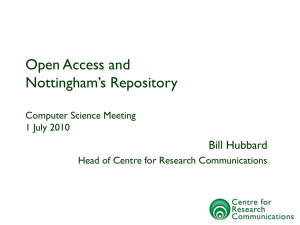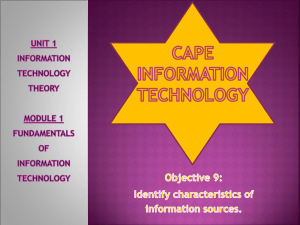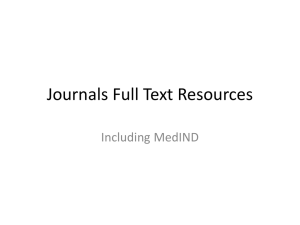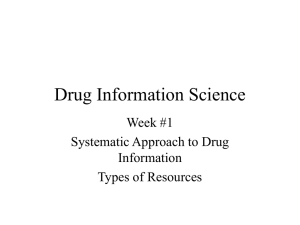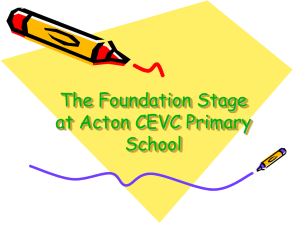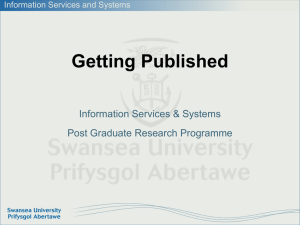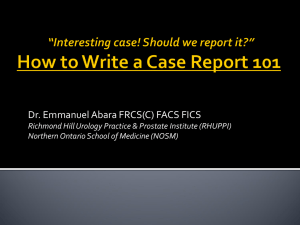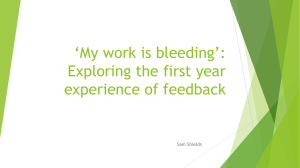Critical Introduction to Open Access
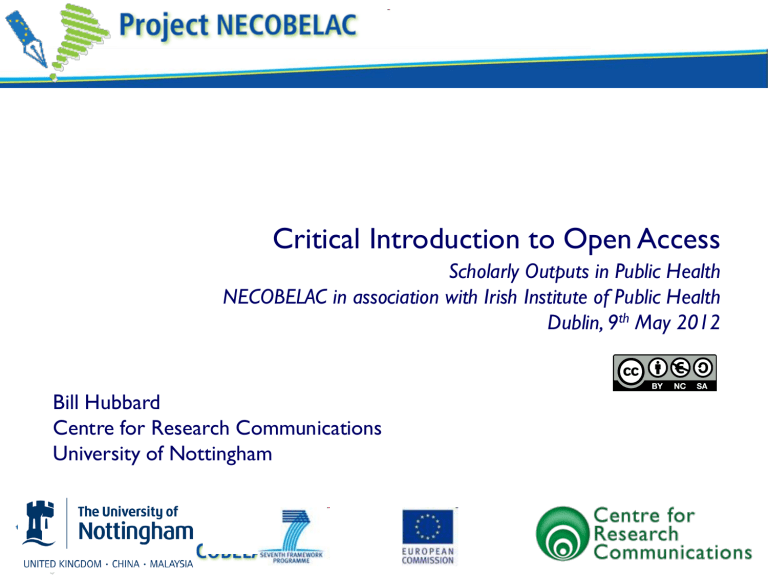
Critical Introduction to Open Access
Scholarly Outputs in Public Health
NECOBELAC in association with Irish Institute of Public Health
Dublin, 9 th May 2012
Bill Hubbard
Centre for Research Communications
University of Nottingham
What is Open Access
An old tradition and a new technology have converged to make possible an unprecedented public good. The old tradition is the willingness of scientists and scholars to publish the fruits of their research in scholarly journals without payment, for the sake of inquiry and knowledge. The new technology is the internet. The public good they make possible is the world-wide electronic distribution of the peer-reviewed journal literature and completely free and unrestricted access to it by all scientists, scholars, teachers, students, and other curious minds. Removing access barriers to this literature will accelerate research, enrich education, share the learning of the rich with the poor and the poor with the rich, make this literature as useful as it can be, and lay the foundation for uniting humanity in a common intellectual conversation and quest for knowledge.
Budapest Open Access Initiative February 14, 2002, Budapest, Hungary http://www.soros.org/openaccess/read.shtml
Why Open Access?
• Serials crisis
• Researcher need for access
• Public need for access
• Moral case
• Author’s benefits
• Institutional benefits
• Financial rationale
• Because we can!
What is Open and what is Access?
• Open to read?
• Open to use?
• Open to re-use?
• Accessible for processing?
• Accessible by the public?
• Accessible by the world?
What is Open Access
• Publications
• Data
• Grey literature
• Conference papers
• Theses
• Arts multimedia
• Teaching and Learning materials
• . . . what else?
What Open Access is not . . .
• A subversion of peer-review
– but academics may want to modify current models
• A replacement for publication
– but the world may want to move that way
• An invitation to plagiarism
– and it may actually become the norm to prevent plagiarism
• An attack on copyright
– but it does throw up some anomalies which lead creators and users to question copyright in its current form
How is Open Access achieved?
• Just sticking it on the web somewhere
– and why that’s not a good idea
• Repositories
– Subject based
– Institutionally based
– Government based
– Funder based
• Journals
– Open Access Journals
– Hybrid Journals
Repository Open Access
Author writes paper
Submits to journal pre-print
Deposit in e-print repository
Paper refereed
Revised by author post-print
Author submits final version
Article published in a journal published version
Journal Open Access
Author writes paper
Submits to journal
Paper refereed
Revised by author
Author submits final version
Article published in a journal
Who wants Open Access?
• Authors like it
• Researchers like it
• Librarians like it
• Institutions like it
• Funders like it
• Research assessment workers like it
• Knowledge transfer workers like it
• Public likes it
• Publishers . . . are split
Public investment compared to publishers’ service
12
10
8
6
4
2 time - months
Blue box Public investment e.g. 2 year project, £300,000
£12,500 per month
£300,000 over 24 months
(and public access to results
may be unavailable)
Red box Publisher’s investment e.g. charge of £1,800
£600 per month
£1,800 over about 3 months
(and expenses recouped through advance payment of subscriptions)
Where we are so far . . .
• Repositories
– 2186 worldwide, 14 Ireland - 207 UK-based
• Journals
– 7696 journals worldwide - plus hybrids
• Funder policies
– Publications: 68, Data: 27, OA Journals: 38
• Institutional policies
– 145 policies reported, plus etheses
• Services and processes in place
Where we are so far . . .
• NIH in the States
• UK - Finch Committee
• UK - David Willetts recent speech
• European Commission - Neelie Kroes
Change is coming . . .
• Developments in the web and ICT alone will produce substantial change and may be the major mechanism for change to current practice . . .
• Financial incentives are changing across Europe
• 10 years timescale - what changes are coming down the track and what responses are needed?
Mendeley
1,319,469
People
112,949
Groups
129,692,213
Papers
30,529
Institutions
Change is here . . .
• Search for “cancer cures” in Google
Cancer Options: The Surprising Power of Mother Nature!!
• God has been good to His children by putting hundreds of natural substances in Mother Nature which can help all cancer patients in many different ways!! Mother Nature's cancer treatments are called "natural cancer treatments" or "alternative cancer treatments."
• For example, the late Dr. William D. Kelley, a dentist by training, used alternative cancer treatments to treat more than 33,000 cancer patients.
He used special diets, proteolytic enzymes, and other natural substances.
Dr. Kelley was able to cure more than 90% of the cancer patients who went to him instead of using chemotherapy, radiation and surgery!!
• Compare Dr. Kelley's cure rate of 90% to the overall cure rate of less than
3% of orthodox medicine!! http://cancertutor.com/
Change is here . . .
• OA repositories and journals offer open access, but with control, authority, transparency and commercial clarity
• OA repositories and journals offer a route for healthcare information to be made available to the public, journalists, healthcare professionals and researchers
Questions?
• Bill Hubbard
• Head of Centre for Research Communications
• bill.hubbard@nottingham.ac.uk
